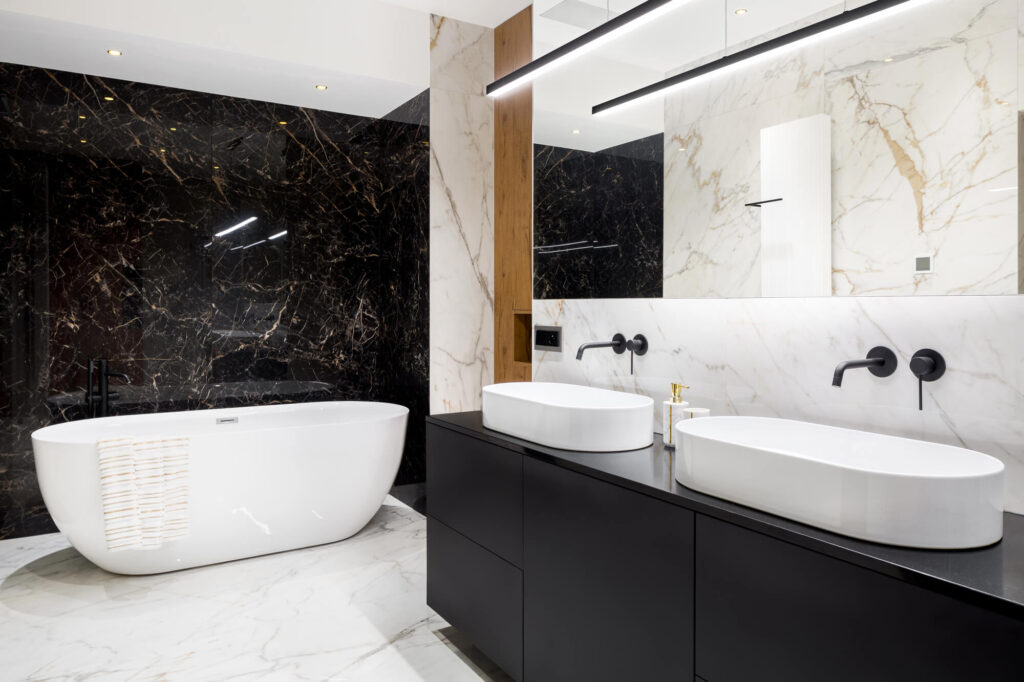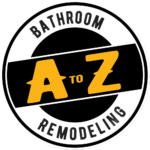When planning a master bathroom renovation or designing a new bathroom, one of the most important questions homeowners face is this: shower or tub? Each has its own set of benefits and drawbacks, and the decision can impact everything from bathroom layout and daily routine to resale value and mobility.
Are you a “shower person” who prefers efficiency, or do you love relaxing in a hot bath with bath salts or bath bombs? Maybe you’re designing with aging-in-place or accessibility in mind, or simply want to enhance your bathroom with modern aesthetics and spa-like features.
At A to Z Bathroom Remodeling, we’ve worked with countless homeowners across the San Antonio metro area who are unsure which bathing option will best create a functional, but stylish, space that reflects their lifestyle and serves their specific needs. This guide breaks down the shower vs tub pros and cons discussion with insights on cost, space, maintenance, safety features, and design tips—plus innovative ideas for small bathrooms and budget-conscious customers.
The Pros and Cons of Installing a Shower
Showers are often the go-to choice in modern bathroom renovations, offering sleek design, functionality, and efficiency. Here’s a breakdown of the key advantages and disadvantages of installing a shower instead of a bathtub.
Pros of Choosing a Shower
- Space Efficiency: A walk-in shower or prefabricated shower can open up your bathroom visually and physically, making it ideal for smaller spaces or powder rooms.
- Accessibility and Safety: Showers with grab bars, non-slip tiles, and a linear drain promote universal design. A walk-in shower with a bench and handheld showerhead is an excellent choice for aging-in-place or mobility concerns.
- Modern Aesthetics: Frameless glass walls, minimal tile grout lines, and modern fixtures like rain shower heads help modernize your design and add luxury to your daily routine.
- Energy and Water Efficiency: Shower systems typically use less water than bathtubs, especially when equipped with water-saving fixtures and heads. This can help lower both energy costs and environmental impact.
- Easier Maintenance: Compared to bathtubs, showers generally require less scrubbing. A nonporous acrylic shower stall, glass shower doors, or waterproof tile can reduce mold and mildew growth.
Cons of Choosing a Shower
- No Soaking Option: For those who enjoy long soaks, hydrotherapy, or relaxing with bath bombs, a shower falls short.
- Resale Considerations: In family homes, real estate professionals often recommend having at least one bathtub. Removing all tubs during a home renovation could negatively impact resale value.
- Installation Challenges: If your bathroom layout wasn’t originally designed for a shower, plumbing updates, waterproofing, and drainage modifications could increase labor costs.
Whether you opt for a sleek custom luxurious shower or a budget-friendly prefabricated unit, showers are a practical upgrade for many modern households. However, they’re not always the best fit for every customer.
The Pros and Cons of Installing a Tub
A bathtub can turn your bathroom into a space for relaxation, family convenience, and luxury.
Pros of Choosing a Tub
- Self-Care and Comfort: There’s no substitute for soaking in a warm bath after a long day. Whether you’re using bath salts, bath bombs, or just hot water for relaxation or recovery, a tub promotes self-care and stress relief.
- Ideal for Families: If you have young kids, a bathtub is often a more practical solution than a shower. It provides safety and ease for bath time.
- Variety of Styles: Homeowners can choose from alcove bathtubs, freestanding tubs, soaking tubs, walk-in tubs, or whirlpool tubs. Each option caters to a different aesthetic and functionality.
- Potential for Increased Resale Value: In many markets, especially suburban areas with family-oriented buyers, having at least one bathtub can improve a home’s resale value. Real estate professionals often emphasize the importance of offering a full bath.
- Hydrotherapy and Aging-in-Place: Walk-in tubs and whirlpool tubs provide therapeutic benefits, especially for people with joint pain or limited mobility. These features support universal design and aging-in-place goals.
Cons of Choosing a Tub
- Takes Up More Space: A standard bathtub requires more square footage than most shower stalls or walk-in showers. This can limit layout flexibility in smaller bathrooms.
- Higher Water Usage: Filling a bathtub typically consumes more water than a standard shower and pushes the limits of many water heaters, which may affect energy costs and environmental impact.
- More Difficult to Access: Tubs can pose mobility challenges for seniors or anyone with physical limitations. Grab bars and non-slip mats help, but they don’t eliminate the step-over barrier.
- Maintenance Requirements: Bathtubs—especially ones with jets or older models—may require more frequent cleaning to prevent mold, mildew, or soap scum buildup. Overflow and waste drains must be checked and maintained to avoid leaks.
- Installation and Labor Costs: Replacing or installing a tub can be more involved than a prefabricated shower, particularly when plumbing updates, waterproofing, or tiling are necessary.
While tubs add a luxurious and functional dimension to a bathroom, they’re not always practical for every lifestyle or floor plan. The right choice depends on your specific goals and constraints.

Comparing Shower and Tub Costs: Budgeting for Your Remodel
When planning a bathroom renovation, the cost difference between a shower and a tub installation can be a deciding factor. While both options come in a range of price points, several key factors affect total investment, including materials, plumbing, labor costs, and desired features.
Typical Bathtub Costs
Bathtubs come in various types, each with its own pricing:
- Alcove bathtub: Typically the most budget-friendly, ranging from $300 to $900 for the unit alone.
- Freestanding tubs: Can cost between $1,000 and $3,000, depending on design and material.
- Walk-in tubs: Built for accessibility and aging-in-place, these often start at $2,500 and can exceed $10,000 with hydrotherapy jets and safety features.
- Whirlpool tubs: Add-ons like water jets, heaters, and overflow drainage increase prices, so expect $1,500 to $5,000 or more.
Don’t forget installation. Labor costs can add $500 to $2,000, depending on your bathroom structure, any necessary plumbing updates, or tile work. Tubs typically require more square footage and potentially more expensive waterproofing.
Typical Shower Costs
Shower installation costs vary based on design and material choices:
- Prefabricated shower stall: A budget-friendly option, generally $400 to $1,200.
- Custom walk-in shower: Includes tile work, glass wall panels, lighting, and advanced drainage like linear drains, ranging from $3,000 to $7,000 or more.
- Tub-shower combo: Combines both functionalities at a moderate cost ($800–$2,500 for the unit), ideal for small bathrooms or customer satisfaction across different preferences.
Additions like showerheads, lighting, glass doors, ventilation fan systems, and waterproofing can quickly increase the remodeling project scope and price. Labor typically runs $1,000 to $3,500, especially with tile installations or complex plumbing.
Cost Considerations for Small Budgets
- Shower-tub combos and alcove bathtubs are among the most affordable and space-efficient solutions.
- Basic prefabricated shower stalls reduce labor time and material expenses.
- Choosing nonporous acrylic over natural tile can cut down on material and maintenance costs.
- Select fixtures with a lifetime warranty and energy-efficient features to improve long-term value and reduce water usage.
- Corner showers or curbless walk-in showers can be smart layout strategies for small bathrooms, while choosing multi-functional fixtures can not only be a space saving solution but can also save your money on water and energy bills
Whether you’re working with a modest budget or seeking high-standard craftsmanship, planning with your contractor around layout, waterproofing, and plumbing is key to controlling bathroom remodel costs without sacrificing quality or modern aesthetics.
Factors to Consider Before Choosing a Shower or Tub
Deciding between a shower and a tub requires careful consideration of lifestyle, aesthetics, mobility, long-term goals, and space. Let’s explore the key elements that should inform your decision.
Household Needs and Lifestyle
Are you a shower person who prefers quick routines, or someone who enjoys long, relaxing baths with bath salts and bath bombs? Your daily habits play a significant role. Showers are typically more efficient for busy mornings, while bathtubs offer self-care and relaxation benefits.
Families with young children or pets often find bathtubs more practical. Meanwhile, singles, couples, or aging adults may prefer the ease and speed of a walk-in shower or a shower-tub combo.
Mobility and Accessibility
For homeowners thinking long-term or planning for aging-in-place, accessibility is essential. Walk-in showers offer easy entry, especially when paired with grab bars, shower benches, non-slip tiles, and a linear drain system. A universal design approach can include features like:
- Walk-in tub or low-threshold shower
- Safety features such as non-slip mats and handrails
- Adjustable showerhead and easy-to-reach faucet controls
These upgrades support users with mobility challenges and reduce the risk of injury in wet conditions.
Space and Layout
The physical space of your bathroom might dictate your options. A standard alcove bathtub typically requires more square footage than a prefabricated shower stall or walk-in shower. In smaller spaces, a corner shower or space-efficient layout may be the only viable option.
If you want the best of both worlds, a shower-tub combo may offer a smart solution without major layout changes. Consider collaborating with your contractor for a bathroom design consultation to ensure you can take advantage of every inch of space without compromising function or comfort.
Water Usage and Environmental Impact
Bathtubs can use up to 70 gallons of hot or cold water per use, while showers generally consume less water, especially those fitted with water-saving properties. Homeowners conscious of energy costs or environmental impact may find modern bathroom renovations with efficient showerheads more appealing.
That said, long showers can still waste water if not properly managed. Incorporating timers, low-flow showerheads, and efficient drainage helps balance comfort with sustainability.
Resale Value and Market Expectations
Real estate professionals often recommend having at least one bathtub in the home for resale appeal. A bathroom without a tub may limit your buyer pool and exclude families altogether.
However, a sleek, modern walk-in shower with glass wall panels, stylish tile, and energy-efficient fixtures may boost home value and attract buyers looking for contemporary upgrades.

Maintenance, Upkeep, and Longevity: What to Expect
The choice between a shower and a tub affects not only your daily routine but also how much maintenance you’ll need to commit to over time.
Showers: Simpler to Maintain, but Not Maintenance-Free
Showers—especially prefabricated units or shower stalls made from nonporous acrylic—tend to be generally easier to clean and maintain. With fewer nooks and crannies than tile-lined tubs, they resist mold and mildew growth better when properly ventilated with a good-quality ventilation fan.
However, tiled showers with glass walls or intricate showerheads may require regular descaling, grout cleaning, and mold prevention treatments. Linear drains and high-end fixtures also need occasional inspection and maintenance to avoid clogging or slow drainage.
Key Maintenance Tips:
- Clean the shower area weekly to avoid soap scum and buildup.
- Use non-slip mats or non-slip tiles to reduce safety risks.
- Ensure proper waterproofing and check seals around the floor and glass wall for damage.
Bathtubs: Comfort with Added Cleaning Needs
It doesn’t matter if they’re freestanding tubs, alcove bathtubs, or whirlpool tubs; they all require more extensive, deep cleaning when compared to showers, particularly if they’re used frequently for long soaks or by multiple household members. Whirlpool tubs need extra care, like careful sanitization of the internal jets to avoid bacteria buildup.
Alcove tubs with tile surrounds may be prone to grout deterioration and water seepage if not sealed properly. Walk-in tubs often include more mechanical components that require routine checks to maintain performance and safety.
Common Maintenance Requirements:
- Clean jets and overflow drains monthly in whirlpool tubs.
- Reseal grout and caulking regularly to prevent mold and water damage.
- Use gentle, non-abrasive cleaners to preserve finishes and materials.
Longevity and Durability Considerations
Durability largely depends on the materials used and the quality of the installation. A high-standard craftsmanship shower or tub, professionally installed by experienced bathroom renovation contractors, can last 15–25 years or longer with proper care.
Tub materials like acrylic, enameled steel, or cast iron tend to last decades, though the finish may fade or chip over time. On the other hand, a well-installed tile shower with durable grout and tile choices can also offer excellent longevity, especially when paired with regular maintenance.
Bottom Line: Regardless of your choice, routine care and proper installation will go a long way in ensuring customer satisfaction and long-term value.
Shower and Tub Design Ideas to Match Any Budget or Bathroom
Your choice between a shower or tub doesn’t just come down to function—it’s also about how each one fits into your bathroom layout, budget, and overall design concept. Fortunately, there are countless ways to tailor either option to your home, no matter the space or spending plan.
Compact and Budget-Friendly Solutions
For homeowners working with limited square footage or tighter budgets, a shower-tub combo (or shower tub combo) is a practical and cost-efficient solution. This design provides the best of both worlds: a full bathtub for soaking or bathing kids, and a shower for quick, daily use.
Opting for a prefabricated shower or alcove bathtub can significantly reduce labor costs and installation time. Prefab units often come with built-in shelving, a non-slip base, and waterproofing already integrated into the structure, which makes them ideal for modern bathroom renovations on a budget.
Smart Additions:
- Install a ventilation fan to reduce moisture buildup and preserve finishes.
- Choose affordable tile or acrylic wall surrounds for easy cleaning and a clean look.
- Use a linear drain for a sleek, space-efficient aesthetic.
High-End Options for Luxury and Functionality
If you have the room and budget to invest, features like freestanding tubs, whirlpool tubs, or walk-in showers with frameless glass walls can elevate the feel of any bathroom renovation. These upscale options not only provide comfort and style but can also increase home value, especially when paired with other upgrades like modern lighting, elegant fixtures, and smart storage.
Luxury features to consider:
- Hydrotherapy jets in tubs for a spa-like self-care experience.
- Water-saving showerheads that offer pressure without high water usage.
- Heated floors and accent lighting to enhance comfort and ambiance.
Stylish Ideas for Midrange Budgets
Midrange remodels can still deliver impressive results with a balance of design and practicality. Consider a custom-tiled shower stall with non-slip tiles, built-in grab bars, and niche shelving for a polished, accessible design. Or, choose an alcove tub with stylish tile accents to blend function with visual appeal.
Popular design choices:
- Contrasting tile patterns to highlight the shower area or tub wall.
- Matte black or brushed gold faucets and showerheads for modern aesthetics.
- Wall-mounted fixtures and floating vanities to make smaller bathrooms feel more open.
No matter your budget, working with an experienced bathroom remodeling contractor can help you source high-quality, cost-effective materials that align with your goals and vision.
Making the Right Choice for Your Needs
Choosing between a shower and a tub comes down to lifestyle, space, budget, and future needs. Showers often win for space efficiency, ease of access, and modern aesthetics, while tubs appeal to those who value self-care, relaxation, and bathing small children.
Consider your goals carefully: are you prioritizing mobility, universal design, or resale value? Do you want a walk-in shower, a shower-tub combo, or something in between? Each option comes with trade-offs in cost, maintenance, water usage, and safety features, so working with a professional can help simplify complex decisions.
At A to Z Bathroom Remodeling, we help you evaluate all options based on your space, lifestyle, and budget. Whether you’re interested in modern bathroom renovations, plumbing updates, or a full bathroom redesign, contact us, and our team will help you craft a solution that brings both comfort and beauty to your home.
